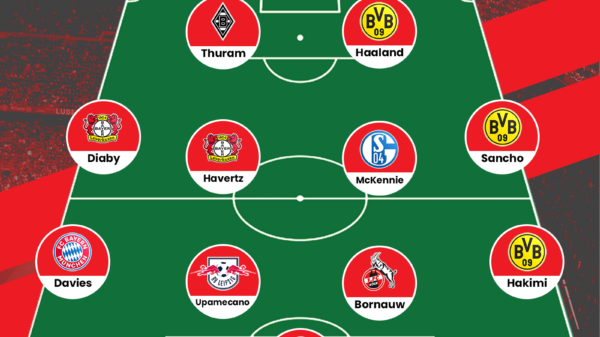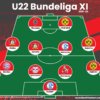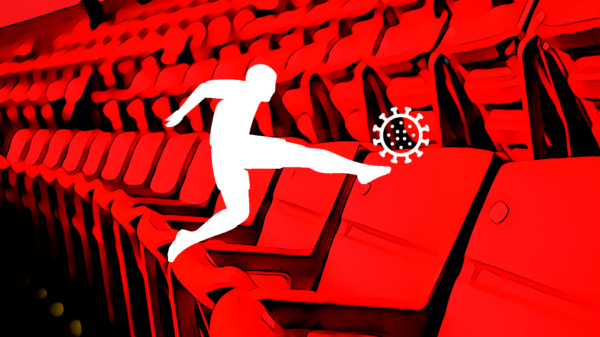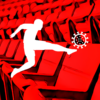After faltering in Jurgen Klopp’s last season with Dortmund, all eyes were on Thomas Tuchel’s attempt to revive the exciting German club to the top of the Bundesliga. Andrew Thompson takes a closer look at how Tuchel faired.
“I am not satisfied that Bayern are now 10 points away, the gap should not have been so big. I am very worried about our ability to compete. We are a long way off and it is self-inflicted. It is a shame that the season felt finished after the thirty-second game day. We stopped playing to the limit. We must find our form and improve our attitude.”
If you ask Thomas Tuchel, this season fell far short of his expectations. The irony of this comes by way of the praise heaped upon him for his successful transition and bringing Borussia Dortmund back to performance levels required.
It was always going to be difficult to replace iconic former manager Jürgen Klopp, but there was surely no one better to press on and take the framework build by Klopp and expounded into what was easily one of the most enjoyable sides to watch in all of Europe this past season. It was a campaign that didn’t end in silverware at home or abroad, but it was a season that signaled progress never the less.
So much more than the letter “A”
No, this is not about to divulge into an episode of Sesame Street, but rather a focus on tactical adjustments brought in by Tuchel that reestablished Dortmund as one of the most enjoyable and vaunted attacking sides on the continent.
Under Klopp, Dortmund were revered for their ability to hit you on the break with Blitzkrieg-like efficiency, but past that, there was little much to their tactical deployment going forward. They often times struggled to dictate the tempo of the match in possession, and had to rely on their bread and better set-up to garner results, something that worked for a time (Klopp did indeed win two Bundesliga titles) but was not sustainable.
Further more, Gegenpress was also not sustainable; with the amount of high-energy efforts necessary to quickly win the ball back and spring another counter often times draining players physically. As part of a tactical dossier, it’s very effective, but to require your players to do it year on year without any shakeup could be costly, and in the case of Dortmund, it’s a major contributing factor to their awful Hinrunde in the 2014/2015 campaign.
With Tuchel, things changed tactically, and so much for the better during the 2015/2016 season – a plan B was established, making the North Rhine-Westphalia far more flexible and more difficult to plan against.
Dortmund would now operate under different deployments on the pitch, mainly the 4-3-3 and 4-2-3-1 depending on opponent and match objectives. In a 4-3-3, Dortmund would look to counter, while the 4-2-3-1 brought possession, build up play and control of proceedings…something so often missed under Klopp, and the numbers reflect the positive outcome. Under Klopp, Dortmund would average around 52% of the ball, while Tuchel’s troops averaged a shade under 60%, demonstrating a greater desire to impose their will on proceedings rather than only be reactionary.


While the above signal two different things, they lend weight to the effectiveness of Dortmund’s revamped attack under Tuchel’s command. Despite the vast majority of chances being created in central areas, and indeed the final third and penalty area, they continued to posses the ability to use the long ball efficiently both in creating chances but also dictating where the build up play would begin.
All told, it’s these key attacking and tactical adjustments that resulted in Die Schwarzgelben leading the Bundesliga in goals scored, something they had not done since 2011/2012, and an ideal additional building block added to the foundation of what hopefully will eventually lead to another league title.
The Gündogan/Weigl duopoly
The key ingredient to Tuchel’s inclusion of possession football into the Dortmund system was control of the midfield. In Ilkay Gündogan, Dortmund already had a player able of dictating play while maintaining the ability to spring the counter with an expertly placed long ball, but what was lacking was a second player capable of the same. Sven Bender, long preferred in midfield as a traditional holding player, was adept at retaining possession, but lacked in the creative department, and it is because of this fact that youngster Julian Weigl emerged during his first season at the club after his move from 1860 München.
While no one could have expected the now full German international to settle as quickly as he did, Weigl’s technical ability, high degree of intelligence and capabilities in possession saw him surge up the depth charts and receive his first start for the club on the opening day of the campaign. All told, he would go on to make 30 domestic appearances (25 as a starter) while Gündogan saw action on 25 occasions (22 as a starter).
| Category | Gündogan | Weigl |
| Total Passes | 88.42 | 92.24 |
| Pass Completion | 88% | 92% |
| Chances Created | 1.18 | 0.64 |
| Average Pass Length | 17.60m | 17.13 |
| Tackles Won | 1.40 | 1.52 |
| Interceptions | 2.49 | 2.48 |
Together, the German national pair averaged a pass completion of about 90%, while completing 162 passes combined (one-fourth of all passes made per 90min by the club), stats that show the vital importance the central pairing had when on the ball. They were not relied upon as the creative focal point, and even though they did have the ability to create chances (reflected in their near two chances per 90min created in tandem), their real assignment was to win the ball back by way of their effectiveness in patrolling opposition supply lines (just a shade under a combined 5 interceptions per 90min) and then dictating tempo to then distribute to the creative work horses that were Shinji Kagawa, Henrik Mkhitaryan and Gonzalo Castro.
When in possession, or even when on the counter, control of the ebb and flow of a match is vital to the success of your tactical deployment. Being a team that can really impose their will on a match is so much more than just having players that can physically dominate the center of the park, but being able to make the right pass, speed up or slow down the collective rhythm and dictate the final move before you say checkmate – when it comes to Gündogan and Weigl, this is very much what Tuchel relied on and it paid dividends.
PEA and Götze 2.0
If there ever were two players who benefitted from a changing of the guard, it was Pierre-Emerick Aubameyang and Henrik Mkhitaryan. Both players were brought in with expectations to reach the next level after staring for AS Saint Etienne and Shakhtar Donetsk respectively. Auba settled well in his first two seasons, hitting 29 goals and 10 assists domestically. Mkhitaryan on the other hand, though starting well in his debut campaign to the tune of 9 goals and 10 assists in the league, his second season saw him suffer tremendously as Dortmund struggled, only finding the net 3 times and registering 4 assists on the home front – insert Tuchel, his new doctrine and revitalization program, and both players exploded to log the best seasons of their professional careers to date.
A key ingredient to their individual and collective success was their deployment in a system that gave them freedom. Under Tuchel, the attacking four of Aubameyang, Mkhitaryan, Kagawa and Marco Reus were all seen as very interchangeable in theory and in practice. While all four had their roles mapped out on the tactics board, during a match they were allowed freedom of movement and interchangeability going forward. So often you would see Mkhitaryan start on the right but routinely pop up centrally and on the left, while Reus and Kagawa would flip flop from central to left and vice versa when Mkhitaryan remained on the right. As for Aubameyang, he wouldn’t be tasked staying through the middle, as he too would find joy tucking out to either flank. They key to all of this was the freedom of invention and the allowance of players to utilize their intellect and understanding of space in front of them – this is something that began under Klopp, but was expounded upon by Tuchel with great success.

Aubameyang is now sought after as one of the most highly prized forwards in Europe, after a season that saw him find the back of the net 36 times (25 in the league, 8 in the Europa League and 3 in the DFB Pokal) in 45 appearances in all competitions – all personal bests. As for Mkhitaryan, he finally came good in ways far exceeding even the man who he was brought in to replace, Mario Götze. He would end the 2015/2016 campaign with 13 goals and 20 assists combined in the Bundesliga and the Europa League, and is now seen as, on form, the best right sided player in Europe bar Lionel Messi.

For a club to genuinely kick on and progress, it’s a vital task for its headmaster to get the absolute maximum of his best attacking players. We saw it this season with the likes of MSN at Barcelona, Lewandowski and co at Bayern, Vardy and Mahrez at Leicester and Zlatan Ibrahimović and Angel Di María at PSG – in the case of Aubameyang and Mkhitaryan, their stellar season owes a great deal of credit to Tuchel and, for the time being at least, puts them amongst the elite attacking cores in Europe.
Faith in youth and moving forward
Let’s face it – Dortmund is a revolving door of superstars and up and coming talented youngsters. Recent seasons have seen the departures of Robert Lewandowski and Mario Götze to rivals Bayern Munich, and now this summer will add Mats Hummels to the list of those who’ve taken the Bundesautobahn to Bavaria, as well as Ilkay Gündogan leaving to his new home at the Etihad in Manchester. But where there is departure there is arrival, and it’s this simple fact of life that Tuchel has already planned for expertly and continues to do so.
This past season saw Weigl come in and play a key role as a 19-year old (now 20), as well as the emergence of 17-year old American forward Christian Pulisic. In addition, highly rated right sided defender/winger Felix Passlack was given time in the first-team as well as three full appearances for the club – all three players will have key roles in the Tuchel regime moving forward.
This summer has already seen Tuchel add further youngsters to the first-team in preparation for building for the long haul, with French wunderkind Ousmane Dembélé brought in from Lique 1 outfit Stade Rennais as well as Spanish midfielder Mikel Merino arriving from CA Osasuna. While it’s business that certainly adds to speculation (though we like to avoid this sort of talk here at OOTB) in regards to the futures of Aubameyang and Mkhitaryan, it demonstrates Tuchel’s willingness to replace key components lost quickly, it shows his ability to put faith in younger players, something that is necessary at all German clubs no matter the size.
It will be incredibly important to continue to build a product both on and off the pitch, and it is certainly true that such a goal is difficult to achieve when you lose your best players on a regular basis to “bigger fish,” the resourcefulness that Tuchel has shown in bringing in younger players (or relying on a Dortmund youth system that grows in quality year on year) that fit the system requirements guarantees continuity for the club.
Final Thoughts
The general consensus is that there could never be a more difficult follow up summer to the one that saw Tuchel replace Herr Klopp…until the happenings of the current one. With the departure of three players who can be seen as near irreplaceable, Tuchel’s biggest task to date at the Westfalenstadion will be the continuation of a project that began in such stunning fashion.
While the losses of Hummels, Mkhitaryan and Gündogan (and perhaps one or two more) will likely be felt, it is surely not the end of the upward progression. If his ingenuity in regards to building upon what Klopp began is any indication, what are a few personnel losses after all.
Make no mistake about it, Thomas Tuchel’s ability as a manager will certainly be tested yet again next season, perhaps even more so than his first in charge. All that can be done now is to keep faith in a man who, by all accounts, has made Jürgen Klopp a fond memory. Perhaps it is most fitting to end my ramblings with in no better way than this…
Vorwärts BvB!
All pictures and statistics are courtesy of Squawka.com and WhoScored.com
Written by Andrew Thompson
- 20 Key Young Players to Watch from 20 Premier League Teams - August 10, 2018
- World Cup 2018: Germany Warning Signs - June 20, 2018
- MLS 2017: Top 5 U-22 Players of the Season - December 6, 2017



























































